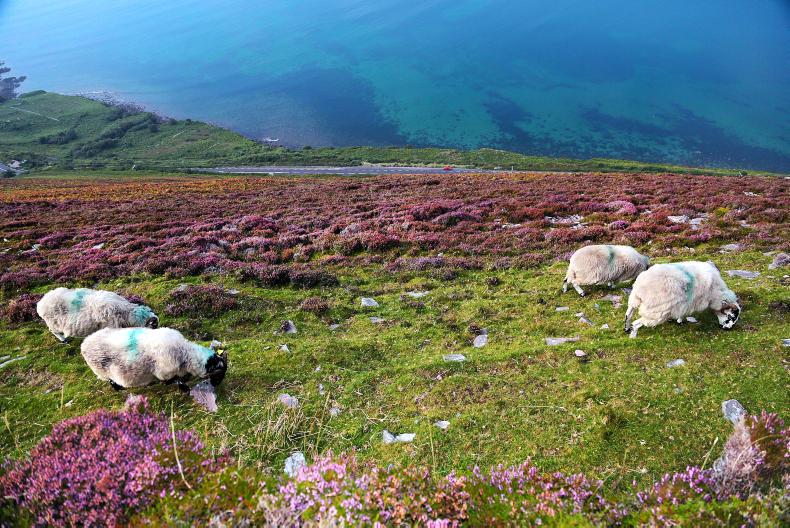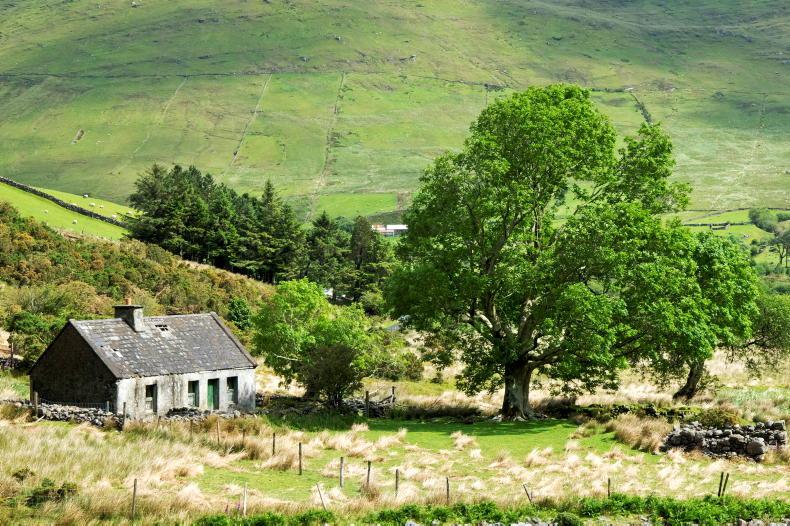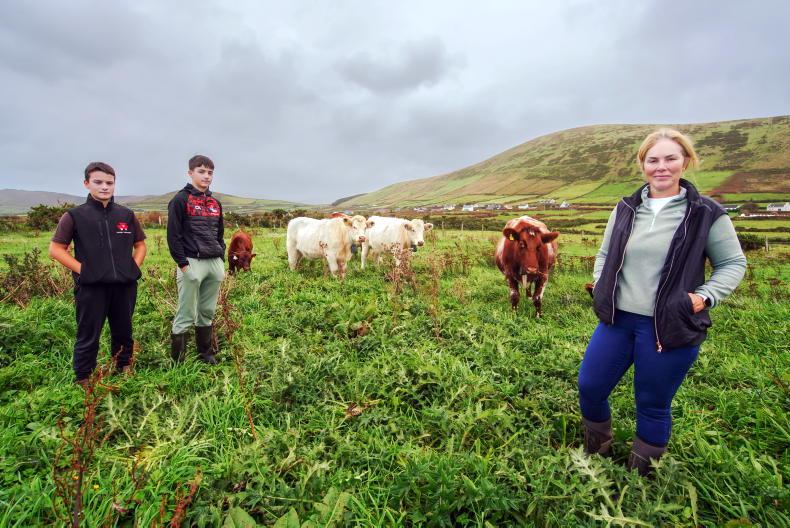The main requirements of the commonage management plan remain to attain the minimum commonage stocking density, which is to be reached by 31 December 2018.
Commonages greater than 10ha are required to have a commonage management plan (CMP), while for commonages under 10ha a commonage farm plan (CFP) is required. Most of these plans have been submitted. However, there are still 299 CMPs outstanding. Monies in respect of 2017 GLAS payments cannot be issued until these CMPs are submitted. Additionally, no further payments will be made until these CMPs are submitted. Under GLAS, farmers receive €120/ha up to a maximum of €5,000, or 42ha.
The plan must identify the months of the year when livestock will graze the commonage and farmers are urged to examine the plan to ensure that they are following it. The minimum recommended time to graze livestock is six months, which may not be an easy target for many farmers. If the decision is made to graze livestock for four or five months, then justification must be provided to the Department. Grazing for less than four months is not permitted.
The CMP is a single plan acting for all of the participating shareholders, prepared by one adviser, with the aim to achieve maximum participation from all the shareholders of the commonage.
The main aim is to try to implement a grazing regime for the commonage. The CMP must take into account the soil type and vegetation on the commonage.
Ewe equivalents
GLAS participants were required to have their individual minimum stocking rate, known as the number of ewe equivalents, by 31 December 2017 and retain this number for the remainder of their GLAS contract. Each CMP must also reach the total minimum number of ewe equivalents for the commonage by 31 December 2018, which again must be maintained for the remainder of the GLAS contract.
Where GLAS III farmers may have joined CMPs that were already set up for GLAS I and II participants, then the GLAS III farmer is required to maintain their individual ewe equivalent for the duration of the contract even after GLAS I and II farmers finish their contract.
However, the overall stocking rate does not have to be maintained. A breakdown of ewe equivalents can be seen in Table 1.

It is important to note that sheep under one year are included with the ewe, with lambs not counted separately in the year that they are born for the purposes of calculating the ewe equivalents.
A CMP cannot exceed the total minimum ewe equivalents for the commonage, which will be outlined on your CMP, at any time during the GLAS contract. Depending on the habitat type present on the commonage, different stocking levels are required. The type of habitat present in your commonage will be identified on your CMP prepared by your adviser, along with individual and total commonage required stocking levels.
There is a flexibility as to how the surplus ewe equivalents are distributed and this will be outlined in your CMP, as long as the total maximum for the commonage is not exceeded.
Stocking exemptions
A derogation from the rules on stocking levels may be granted by lodging an appeal to the commonage implementation committee for derogations. This will only be granted in exceptional cases.
For derogation to be granted, each participant must have delivered at least 50% of their individual stocking density by the end of 2016 for GLAS I and II participants while for GLAS III it was the end of 2017.
All sheep on the commonage must be branded with the flock owner’s colours or markings. The CMP must also list other management requirements which have to be undertaken on the commonage, including actions such as controlled burning and control of invasive species etc. These must be carried out as per the maps submitted with the CMP and within the time frame outlined. All farmers are required to submit an annual sheep census. Each farmer’s individual CMP contract commences on the same date as the GLAS contract so some farmers in GLAS I are already halfway through their contracts. Read more
Top five counties awaiting approved GLAS payments
ANC increase targets smaller hill farms
The main requirements of the commonage management plan remain to attain the minimum commonage stocking density, which is to be reached by 31 December 2018.
Commonages greater than 10ha are required to have a commonage management plan (CMP), while for commonages under 10ha a commonage farm plan (CFP) is required. Most of these plans have been submitted. However, there are still 299 CMPs outstanding. Monies in respect of 2017 GLAS payments cannot be issued until these CMPs are submitted. Additionally, no further payments will be made until these CMPs are submitted. Under GLAS, farmers receive €120/ha up to a maximum of €5,000, or 42ha.
The plan must identify the months of the year when livestock will graze the commonage and farmers are urged to examine the plan to ensure that they are following it. The minimum recommended time to graze livestock is six months, which may not be an easy target for many farmers. If the decision is made to graze livestock for four or five months, then justification must be provided to the Department. Grazing for less than four months is not permitted.
The CMP is a single plan acting for all of the participating shareholders, prepared by one adviser, with the aim to achieve maximum participation from all the shareholders of the commonage.
The main aim is to try to implement a grazing regime for the commonage. The CMP must take into account the soil type and vegetation on the commonage.
Ewe equivalents
GLAS participants were required to have their individual minimum stocking rate, known as the number of ewe equivalents, by 31 December 2017 and retain this number for the remainder of their GLAS contract. Each CMP must also reach the total minimum number of ewe equivalents for the commonage by 31 December 2018, which again must be maintained for the remainder of the GLAS contract.
Where GLAS III farmers may have joined CMPs that were already set up for GLAS I and II participants, then the GLAS III farmer is required to maintain their individual ewe equivalent for the duration of the contract even after GLAS I and II farmers finish their contract.
However, the overall stocking rate does not have to be maintained. A breakdown of ewe equivalents can be seen in Table 1.

It is important to note that sheep under one year are included with the ewe, with lambs not counted separately in the year that they are born for the purposes of calculating the ewe equivalents.
A CMP cannot exceed the total minimum ewe equivalents for the commonage, which will be outlined on your CMP, at any time during the GLAS contract. Depending on the habitat type present on the commonage, different stocking levels are required. The type of habitat present in your commonage will be identified on your CMP prepared by your adviser, along with individual and total commonage required stocking levels.
There is a flexibility as to how the surplus ewe equivalents are distributed and this will be outlined in your CMP, as long as the total maximum for the commonage is not exceeded.
Stocking exemptions
A derogation from the rules on stocking levels may be granted by lodging an appeal to the commonage implementation committee for derogations. This will only be granted in exceptional cases.
For derogation to be granted, each participant must have delivered at least 50% of their individual stocking density by the end of 2016 for GLAS I and II participants while for GLAS III it was the end of 2017.
All sheep on the commonage must be branded with the flock owner’s colours or markings. The CMP must also list other management requirements which have to be undertaken on the commonage, including actions such as controlled burning and control of invasive species etc. These must be carried out as per the maps submitted with the CMP and within the time frame outlined. All farmers are required to submit an annual sheep census. Each farmer’s individual CMP contract commences on the same date as the GLAS contract so some farmers in GLAS I are already halfway through their contracts. Read more
Top five counties awaiting approved GLAS payments
ANC increase targets smaller hill farms












SHARING OPTIONS